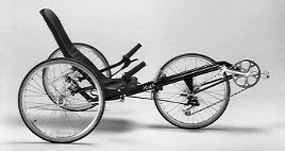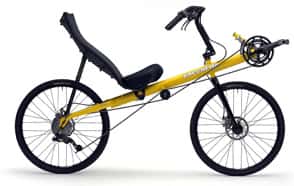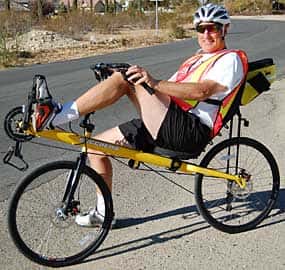First-person account: Bacchetta Giro 26
I’ve had my Bacchetta Giro 26 recumbent high-racer since October 2009, and I’m really enjoying it.

My interest in recumbents started in mid-1996, after bad accident on my diamond-frame bike convinced me I needed to ride something closer to the ground. After riding various SWB and LWB recumbents, eventually I settled on Bill Mason’s beautiful FWD Tricumbent Raven. At that time, I was riding on the Santa Ana bike path almost exclusively, so vehicle width and visibility to cars were of little concern.
In late 2004, though, I moved to an area with no bike paths and few bike lanes. I tried riding my trike once or twice, but I never felt secure. I bought a nice diamond frame (2010 Trek 7.3 FX), thinking I might get used to it, but I was soon reminded why they’re called wedgies.
Also, my wrists were killing me due to the lingering effects of my previous accident. So, I started shopping for a two-wheel recumbent, preferably one with USS.
USS is difficult to come by these days, though, so I decided to check out the Rans Stratus XP, with its dual 26-inch wheels. It felt as fast as they said it would be, but in an hour of riding I couldn’t get used to the steering tiller, and I didn’t really feel as though I would ever get accustomed. I also checked out the Longbikes Slipstream, which has USS as does my trike, but it looked to be a lot of bike and it costs a lot of money.
While I was riding around on the Stratus, I passed a guy on a Carbent Raven high racer. I hadn’t tried a high racer because they have OSS and the seating position seemed so improbable — I didn’t think I’d ever be able to get my balance on one.
I then came across the Cruzbike, which immediately struck a chord. Cruzbikes are full-suspension high racers with front wheel drive. Perfect … except that the largest frame is still a bit small, and the gearing is pure mountain bike: I’d never be able to keep up with the lycra crowd.

The Cruzbike did lead me further into investigating high racers. After winnowing out the various options, there seemed one clear choice: Bacchetta. Both the Strada and the Giro 26 are available for my XXL
outseam/x-seam measurement, and each is rated to handle loads well above my weight. I sought out every account of first-time rides on Bacchettas and other high racers, including some videos on YouTube. It didn’t hurt that Bacchetta has a great looking website. I also remembered that when I got my new Trek, it took a couple of weeks before I felt as competent as I thought I should be, even though I did feel at home
right away as one does on diamond frames. I figured that if I could get even close to confident riding a high racer during a test ride, a little seat time would take care of the rough edges. Other people seemed to be able to cope, after all, so I decided to give it a try. I made arrangements with Bent Up Cycles in Van Nuys, CA, for a test ride.
Within moments of my first takeoff, I felt that this was a bike on which I could get comfortable with a little experience. At first I was attracted to the Bacchetta Strada because of the lighter weight and reputation for being speedier than the Giro 26. However, the Giro’s disc brakes, 26-inch tires, and room in the frame to upgrade to 700c wheels and tires got me rethinking my choice. When I noticed that the Giro gearing was slightly more to my liking than that of the Strada, I went with the Giro 26.
I first tried the Recurve seat, which is very comfortable, but eventually went with the Euromesh, more than anything else because it looked and felt more similar to the seat on my Tricumbent Raven than did the Recurve.
Kate and Dana at Bent Up Cycles did a great job of getting the Giro 26 set up for me, so I’ve had to make only minor adjustments (that is, no tools required) since the initial set-up.

Since buying my Giro 26, I’ve been out nearly every day — even if only for a short ride -- to get more acclimated to the balance differences between my diamond frame and my high racer. As hoped, each day brings new confidence and abilities in terms of balance, comfort, speed, turning, object avoidance, etc. In another week or two, I feel that I’ll be ready to ride in a pack without causing a pile-up. As an aside, given the quality of the road surfaces where I live, I thought the wide
tires on the Giro might be better suited than the narrow tires on the Strada. As it turns out, the wide
tires on my Giro are virtually the same width as the tires on my Trek 7.3 FX, which is to say that they seem just fine.
Getting a recumbent for me is all about comfort. Compared to the Trek, my head is about two feet lower on the Giro, so I don’t get the feeling that my center of gravity is hovering above the front axle. I also love the feeling of security from the feet-first position. When I ride, my head is naturally pointing slightly skyward, which makes it easier to monitor what’s going on around me and to sight-see: There’s a lot to be said for watching the scenery as you cycle, instead of the rotation of the front tire.
I don’t know about speed compared to my diamond frame, but I am typically in a higher (sometimes much higher) gear over the same sections of road, and it feels as if I am really cutting through the wind better -- which you would expect. The first couple days out, it was exhausting having to monitor my pedaling, steering, balance, speed, etc. By the third day, I reached a point where I would be pedaling along and suddenly realize that I’d just gone the better part of a mile without paying attention to any of those things. The more I ride, the less I have to focus on the mechanics of riding, and the more I enjoy the ride itself. It’s really wonderful.
The Giro 26 does have fast
steering ’ not only compared to a trike or a LWB recumbent but also to my diamond frame. However, after the first hour on the bike this becomes a neglible factor, and the steering now seems very well mated to the rest of the Giro’s responsiveness. I can only briefly ride hands off on the Giro, but then, the same goes for my diamond frame. Another aside: Unlike my trike, there is little to no pedal steer with the Giro 26.
Differences in seating position and leg motion gave me some minor discomfort in my low back, knees, and shoulders at first, but a small seat adjustment, relaxing more during rides, and getting in better shape have all but eliminated these. Even better, when I do get discomfort, standing up for a couple of minutes is enough to banish it, compared to the hours of agony after getting off my diamond frame.
The Bacchetta Giro 26 is very eye-catching, judging by the reactions of the people I pass. I also purchased a Bent Up Cycles Aero Bag, in yellow to match the Giro frame, and it integrates so well that it appears to have been part of the cycle to begin with.
Thanks to Dana and Kate for spending the time and getting me into such a wonderful bike.